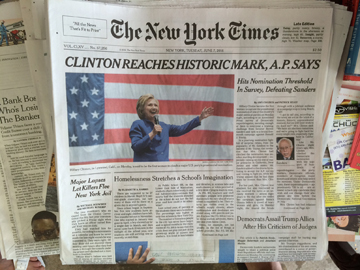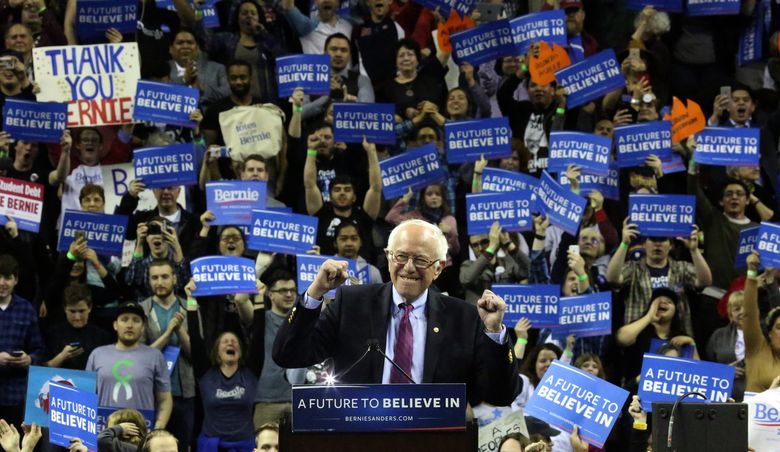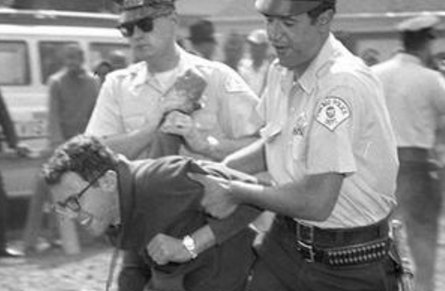 Unless you follow politics closely, you could be forgiven for thinking that Hillary Clinton has locked up the Democratic presidential nomination. This is not true. She still doesn’t have the requisite number of delegates. That could, and probably will, happen next month when her lead in superdelegates puts her over the top at the Democratic National Convention in Philadelphia – when the superdelegates actually, you know, cast their actual votes.
Unless you follow politics closely, you could be forgiven for thinking that Hillary Clinton has locked up the Democratic presidential nomination. This is not true. She still doesn’t have the requisite number of delegates. That could, and probably will, happen next month when her lead in superdelegates puts her over the top at the Democratic National Convention in Philadelphia – when the superdelegates actually, you know, cast their actual votes.
The media, however, doesn’t want you to know that Bernie Sanders is still in the race. And so, based on that flimsiest of measures – an opinion survey of superdelegates who are allowed to change their mind at any point before July’s DNC – they’ve called the Democratic race for Clinton.
This completely illogical reasoning logically leads pundits to the question of the month: how can the Hillary Clinton campaign convince progressive supporters of Bernie Sanders – whose race was largely based on the assumption that Clinton is so far to the right that she might as well be a Republican – to vote for her?
Every four years mainstream political writers and commentators push Democrats to the right after the primaries, arguing that swing voters decide presidential elections. Like trickle-down economics, however, that doesn’t seem to have been true any time in the recent past. Political parties seem to perform best when they motivate their base to turn up at the polls. Given the fact that Republican voters are congenitally more likely to fall in line behind their nominee even if he turns out to be a potato – or, this year, a proto-fascist – than Democrats, it’s obvious to everyone that Hillary Clinton will need as many Bernie Sanders supporters as possible in November if she indeed becomes her party’s nominee.
Obvious to everyone but Hillary.
Last week, NBC’s Lester Holt asked her about Sanders: “Can you name one idea that he’s put forward that you want to embrace? That he has really changed your position on?”
Her answer: a big fat negatori.
“Well, it’s not that so much as the passion that he brought to the goals that–his campaign set,” said Clinton.
Granted, I can’t think of anything she could do to get me to vote for her. But there are millions of Sanders voters who could be convinced not to sit home on election day, support a third-party candidate like Jill Stein or Gary Johnson, or defect to Donald Trump. She’ll need those voters if there are any more Orlando-style terrorist attacks (great for Trump’s fear-based campaign) or, for that matter, after presidential debates in which I expect Trump to savage her.
Maybe Debbie Wasserman Schultz can schedule those debates for the middle of the night on Kazakhstani state television.
Except when she’s hanging out with investment bankers and Walmart board members, Hillary Clinton reflexively refuses to compromise. If she continues her “I have nothing to learn from Bernie and he’ll be lucky to get a speech at the convention” attitude, however, better get prepared for President Trump.
What do Bernie Sanders supporters want? As Trump says, everything is negotiable. So let’s negotiate!
“Add back the public option to the Affordable Care Act,” Howard Dean suggests to Hillary in the New York Times. “Let Americans vote with their feet about whether they want to be in a single payer or the current system.”
The problem with that is, big insurance companies bribed her with $13 million in campaign contributions to get her to say that single payer “will never, ever come to pass.”
Dean wants Clinton to back Sanders’ “massive overhaul of the criminal justice system, starting with emptying for-profit prisons and juvenile detention centers.”
Nice idea, except that here too, she’s owned: she collected as many big donations from lobbyists for the for-profit prison industry as Marco Rubio.
He also wants her to embrace Bernie’s push for reforming Wall Street – but how likely is it that someone who made over $100 million giving speeches to scumbags in the financial services industry will turn against her backers?
“She should release the transcripts of her speeches and explain any of the objectionable things she said in them,” says Stephanie Rioux. If Clinton were going to show us her speeches, it would already have happened.
It may not feel like it now, but Hillary Clinton is in a pickle.
Her supporters keep citing her willingness to support Barack Obama after her defeat in 2008 as an example Bernie Sanders ought to emulate now. But Clinton and Obama were ideologically virtually identical. Both were members of the right-wing Democratic Leadership Council. True, Obama pretended to oppose the Iraq war, which Clinton supported. But Obama wasn’t in the Senate in 2003. When he did get the chance to vote on Iraq, he voted six times out of six in favor of funding it. And he continued the war long after he took office.
Conversely, there’s a huge gap between Clintonism and Sandersism. Bernie Sanders is essentially a Democrat circa George McGovern in 1972: he favors big government antipoverty programs, socialized medicine, and a limited role for the US military overseas. He’s skeptical of free trade agreements, and hasn’t met a Wall Street banker that he likes. Hillary Clinton isn’t just against all that – she’s diametrically opposed, essentially a Republican circa George W. Bush in 2003, many of whose advisers she shares.
“Sanders supporters…are motivated not by animosity toward Hillary Clinton but by a sophisticated analysis and belief that the system is irreparably broken and compromised,” says Sanderista Jonathan Tasini. Actually, only the second half of that sentence is true. As anyone who has attended a Bernie rally can tell you, there’s plenty of animosity toward Clinton.
So what does Hillary Clinton do if she wants to win?
She’ll have to sell out some of her big corporate donors – and she’ll have to do it in a big way. If she goes big, she could appoint Bernie Sanders as her vice president – a sure path to victory – or as an economic czar, like giving him both the secretary of the treasury and the head of the Federal Reserve Bank.
Failing that, she’ll have to adopt at least a few of Bernie’s major platform planks. But here’s the rub. Even if she does, are Bernie’s supporters naïve enough to think that she would follow through?
(Ted Rall is the author of “Bernie,” a biography written with the cooperation of Democratic presidential candidate Bernie Sanders. His next book, the graphic biography “Trump,” comes out July 19th and is now available for pre-order.)


 After disaster strikes, it often turns out that there were several contributing factors behind it. Looking back, though, there was usually one key moment when One Really Bad Decision was made — when catastrophe might have been avoided had the people in charge done something different.
After disaster strikes, it often turns out that there were several contributing factors behind it. Looking back, though, there was usually one key moment when One Really Bad Decision was made — when catastrophe might have been avoided had the people in charge done something different. Hillary Clinton’s coronation at the Democratic national convention is likely but not a foregone conclusion. Since the superdelegates won’t vote until July, and neither she nor Bernie Sanders will arrive in Cleveland with the requisite number of pledged delegates to clich the nomination, there is still the possibility that the party bosses will see sense, internalize the polls that show she’s weaker than him against Trump, and push the superdelegates to support the populist senator from Vermont.
Hillary Clinton’s coronation at the Democratic national convention is likely but not a foregone conclusion. Since the superdelegates won’t vote until July, and neither she nor Bernie Sanders will arrive in Cleveland with the requisite number of pledged delegates to clich the nomination, there is still the possibility that the party bosses will see sense, internalize the polls that show she’s weaker than him against Trump, and push the superdelegates to support the populist senator from Vermont.
 Hey Bernie supporters: Hillary has a talking point for you.
Hey Bernie supporters: Hillary has a talking point for you.

